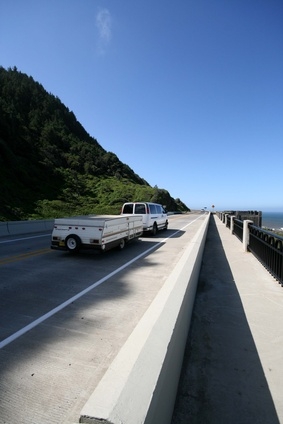
Although changing a tire on a travel trailer is very similar to changing a tire on a car or truck, the sheer size of the trailer may make it more difficult. A heavy travel trailer usually weighs more than a standard car, meaning the amount of physical exertion required to jack up the vehicle and remove the lug nuts may be increased. Having tools especially designed for your travel trailer can help; so can knowing the basics of changing a tire before you encounter a problem on the road.
Move your vehicle and the attached trailer to a safe area. Because these trailers can be substantially larger than a standard car or truck, safely changing the tire may require more room. If the nearest shoulder isn't large enough, move to a parking lot (if possible). Always make sure you are working on a flat surface.
Locate your trailer's spare tire (if your trailer doesn't already have a spare, look in its owner's manual for tire specs so you can order one before you need it). Take the spare tire and any other tools you'll need -- such as a tire iron -- and set them next to the flat tire. The automotive website Edmunds.com also recommends using an air pressure gauge to test the air pressure in your spare tire to make sure it is appropriately filled.
Place wheel blocks behind all the wheels (except the one with the flat tire) on both the travel trailer and the vehicle. Double check that your vehicle is in gear with the emergency brake on.
Loosen the lug nuts on the flat tire using a tire iron (an L-shaped tool that gives users more leverage when removing sticky lug nuts), but do not remove them. The flat tire should still be on the ground at this point.
Place the jack under your vehicle (read the owner's manual for the appropriate spot to place the jack, as this varies by vehicle; placing the jack on the wrong spot can damage the trailer). You may choose to use a standard jack, or a tool specifically designed for a trailer such as "Trailer Aid" (see Resources). A tool like this may make it easier to raise a heavy travel trailer. Raise your trailer until the flat tire is completely off the ground.
Pop the hubcap off the flat tire. Lay it face down next to you.
Remove the lug nuts loosened in Step 4 completely. Put the lug nuts inside the hubcap. This allows the hubcap to act as a "bowl" to hold the lug nuts, and keep them from rolling away.
Hold the spare tire in place so that it lines up with the wheel studs. This step will be easier if you have two people -- one to hold the tire and the other to look for proper alignment. Slide the tire onto the wheel studs.
Place the lug nuts onto the new tire, but do not tighten them yet.
Lower the car from the jack, but keep the wheel blocks in place.
Tighten the lug nuts you replaced in Step 9. To tighten the lug nuts, use a "Five Star" pattern: screw on the first nut (it can be any of the five on your wheel's hubcap), then screw on the nut furthest away from the first. Installing lug nuts in this pattern is best for the vehicle, because it guarantees proper alignment of the tire and prevents unnecessary wear and tear.
Pop the hubcap back on to the wheel. Remove the wheel blocks. You're done!